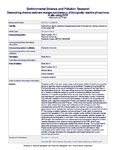Determining riverine sediment storage mechanisms of biologically reactive phosphorus in situ using DGT
| dc.contributor.author | Burns, EE | |
| dc.contributor.author | Comber, Sean | |
| dc.contributor.author | Blake, William | |
| dc.contributor.author | Goddard, Rupert | |
| dc.contributor.author | Couldrick, L | |
| dc.date.accessioned | 2015-11-10T16:32:14Z | |
| dc.date.accessioned | 2015-11-12T08:24:41Z | |
| dc.date.available | 2015-11-10T16:32:14Z | |
| dc.date.available | 2015-11-12T08:24:41Z | |
| dc.date.issued | 2015-07 | |
| dc.identifier.issn | 0944-1344 | |
| dc.identifier.issn | 1614-7499 | |
| dc.identifier.uri | http://hdl.handle.net/10026.1/3801 | |
| dc.description.abstract |
Phosphorus (P) is the main reason many surficial water bodies in the UK are currently failing to meet the chemical standards set by the Water Framework Directive (WFD). This work focuses on the role of sediments in the upper reaches of the River Taw in the South West of the UK. Point and diffuse sources of P have been identified as well as a number of mitigation measures applied or planned to address the issues. However, it is unknown what effect these sources have had on the river's sediments and how they will react to diminishing inputs of P into the water column in the future. The diffusive gradient in thin-films (DGT) method is utilised in situ to quantify and identify labile, potentially bioavailable P fluxes and potential storage mechanisms at sites of known diffuse and point P inputs. In the vicinity of a heavily contaminated point source, data present here shows that sediments are still acting as a sink. The proposed mechanism for this is the formation of a 'calcium cap' which provides a geochemical barrier between the sediment and overlying water to prevent loss of labile P. The strong correlation between calcium and total P under most circumstances supports this hypothesis. This conclusion provides some confidence that even though P concentrations in some sediments are significantly elevated, mobility between the sediment and overlying water is restricted. In the context of routine monitoring against WFD targets, the molybdenum blue method generally employed to determine soluble reactive phosphorus was shown to not be equivalent to the DGT labile P pool, especially at pristine or moderately point/diffuse influenced sites. This is likely due to desorption of weakly bound P from colloids, which is unavailable to DGT devices. These results have the potential to be scaled up to the full catchment or other catchments which exhibit similar physical and chemical sediment composition and provide a stronger foundation for management and target setting than current monitoring approaches. | |
| dc.format.extent | 9816-9828 | |
| dc.format.medium | Print-Electronic | |
| dc.language | en | |
| dc.language.iso | eng | |
| dc.publisher | Springer Science and Business Media LLC | |
| dc.relation.replaces | http://hdl.handle.net/10026.1/3786 | |
| dc.relation.replaces | 10026.1/3786 | |
| dc.subject | DGT | |
| dc.subject | Phosphorus | |
| dc.subject | Freshwater | |
| dc.subject | Eutrophication | |
| dc.subject | Sediment storage mechanisms | |
| dc.title | Determining riverine sediment storage mechanisms of biologically reactive phosphorus in situ using DGT | |
| dc.type | journal-article | |
| dc.type | Journal Article | |
| dc.type | Research Support, Non-U.S. Gov't | |
| plymouth.author-url | https://www.webofscience.com/api/gateway?GWVersion=2&SrcApp=PARTNER_APP&SrcAuth=LinksAMR&KeyUT=WOS:000356937900025&DestLinkType=FullRecord&DestApp=ALL_WOS&UsrCustomerID=11bb513d99f797142bcfeffcc58ea008 | |
| plymouth.issue | 13 | |
| plymouth.volume | 22 | |
| plymouth.publication-status | Published | |
| plymouth.journal | Environmental Science and Pollution Research | |
| dc.identifier.doi | 10.1007/s11356-015-4109-3 | |
| plymouth.organisational-group | /Plymouth | |
| plymouth.organisational-group | /Plymouth/Admin Group - REF | |
| plymouth.organisational-group | /Plymouth/Admin Group - REF/REF Admin Group - FoSE | |
| plymouth.organisational-group | /Plymouth/Faculty of Science and Engineering | |
| plymouth.organisational-group | /Plymouth/Faculty of Science and Engineering/School of Geography, Earth and Environmental Sciences | |
| plymouth.organisational-group | /Plymouth/REF 2021 Researchers by UoA | |
| plymouth.organisational-group | /Plymouth/REF 2021 Researchers by UoA/UoA06 Agriculture, Veterinary and Food Science | |
| plymouth.organisational-group | /Plymouth/REF 2021 Researchers by UoA/UoA14 Geography and Environmental Studies | |
| plymouth.organisational-group | /Plymouth/Research Groups | |
| plymouth.organisational-group | /Plymouth/Research Groups/BEACh | |
| plymouth.organisational-group | /Plymouth/Research Groups/Marine Institute | |
| plymouth.organisational-group | /Plymouth/Users by role | |
| plymouth.organisational-group | /Plymouth/Users by role/Academics | |
| plymouth.organisational-group | /Plymouth/Users by role/Researchers in ResearchFish submission | |
| dc.publisher.place | Germany | |
| dcterms.dateAccepted | 2015-01-11 | |
| dc.identifier.eissn | 1614-7499 | |
| dc.rights.embargoperiod | Not known | |
| rioxxterms.versionofrecord | 10.1007/s11356-015-4109-3 | |
| rioxxterms.licenseref.uri | http://www.rioxx.net/licenses/all-rights-reserved | |
| rioxxterms.licenseref.startdate | 2015-07 | |
| rioxxterms.type | Journal Article/Review |


